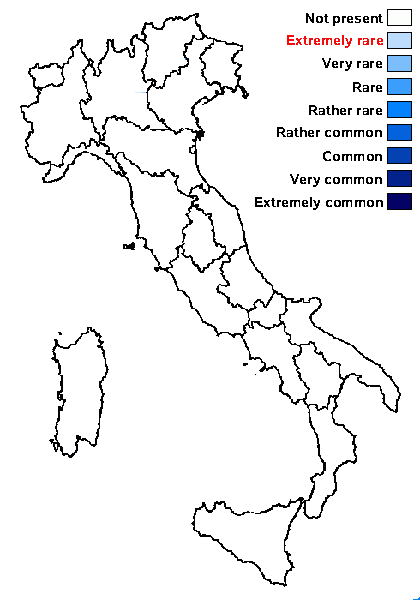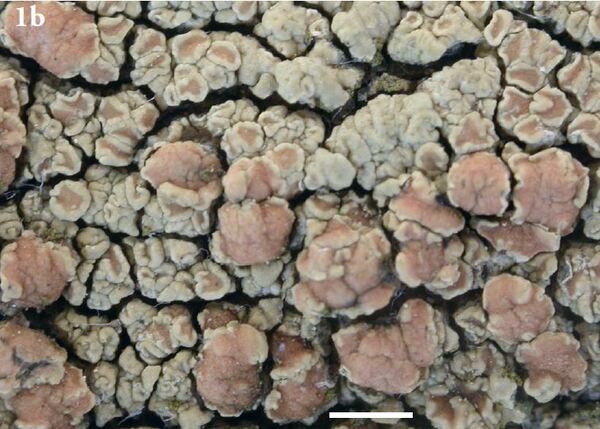Lecanora crassiuscula Cl. Roux, Poumarat & M. Bertrand
in Roux & al., Bull. Soc. linn. Provence, 73: 80, 2022.
Synonyms:
Distribution:
Description: Thallus crustose, episubstratic, areolate, yellowish white to yellowish green, somehow glossy, forming up to 10 cm wide patches, without a distinct prothallus. Areoles (0.2-)0.4-1.6(-2.3) mm wide, (0.2)0.3-0,6(-0.85) mm thick, finally glebulose and sometimes slightly lobulate, flat to slightly convex, the peripheral ones slightly elongate. Cortex 35-60 μm thick, with a colourless, 1-5 μm thick epinecral layer with numerous yellowish crystals insoluble in N and soluble in K, overlaying a paraplectenchymatous layer which is yellowish and rich in crystals in upper part, colourless in lower part; algal layer at first continuous, then interrupted; medulla 130-700 μm thick, arachnoid, with a few large crystals soluble in N, insoluble in K. Apothecia lecanorine, (0.25-)0.5-1.6(-1.9) mm across, adnate to sessile, finally sometimes deformed by mutual compression, with a slightly concave to convex, pale brown, epruinose, sometimes umbonate disc and an entire to wavy, 0.1-0.2 mm thick, finally sometimes excluded thalline margin. Thalline exciple 85-190 μm thick, corticate, the cortex of more or less anticlinally arranged hyphae with numerous colourless and yellowish crystals; proper exciple colourless, 65-110 μm thick, rich in crystals, with a paraplectenchymatous upper part and a prosoplectenchymatous lower part; epithecium yellowish brown 12-22 μm high, with crystals and granules; hymenium colourless, 45-85 μm high, without crystals in lower part, I+ blue; paraphyses coherent, simple or sparingly branched and anastomosing, 1.5-2 μm thick at base, the apical cells 2-4 μm wide; subhymenium colourless, 35-100 μm high, without crystals; hypothecium colourless. Asci 8-spored, clavate, Lecanora-type. Ascospores 1-celled, hyaline, ellipsoid to ovoid, (8.5-)9-12.5 x (5.5-)6-7.5(-8) μm, thin-walled. Pycnidia rare. Conidia thread-like, curved to sigmoid, 24-31 x 0.5-1 μm. Photobiont chlorococcoid. Spot tests: K-, C-, KC+ pale yellow, P-. Chemistry: usnic acid. Note: a recently-described species found on inclined surfaces of siliceous rocks at low altitudes. Hitherto known from France (Bouches-du-Rhône, Var); to be looked for in Italy. The description is based on Roux & al. (2022).
Growth form: Crustose
Substrata: rocks
Photobiont: green algae other than Trentepohlia
Reproductive strategy: mainly sexual

Predictive model
Growth form: Crustose
Substrata: rocks
Photobiont: green algae other than Trentepohlia
Reproductive strategy: mainly sexual

Predictive model
 Index Fungorum
Index Fungorum
 GBIF
GBIF


